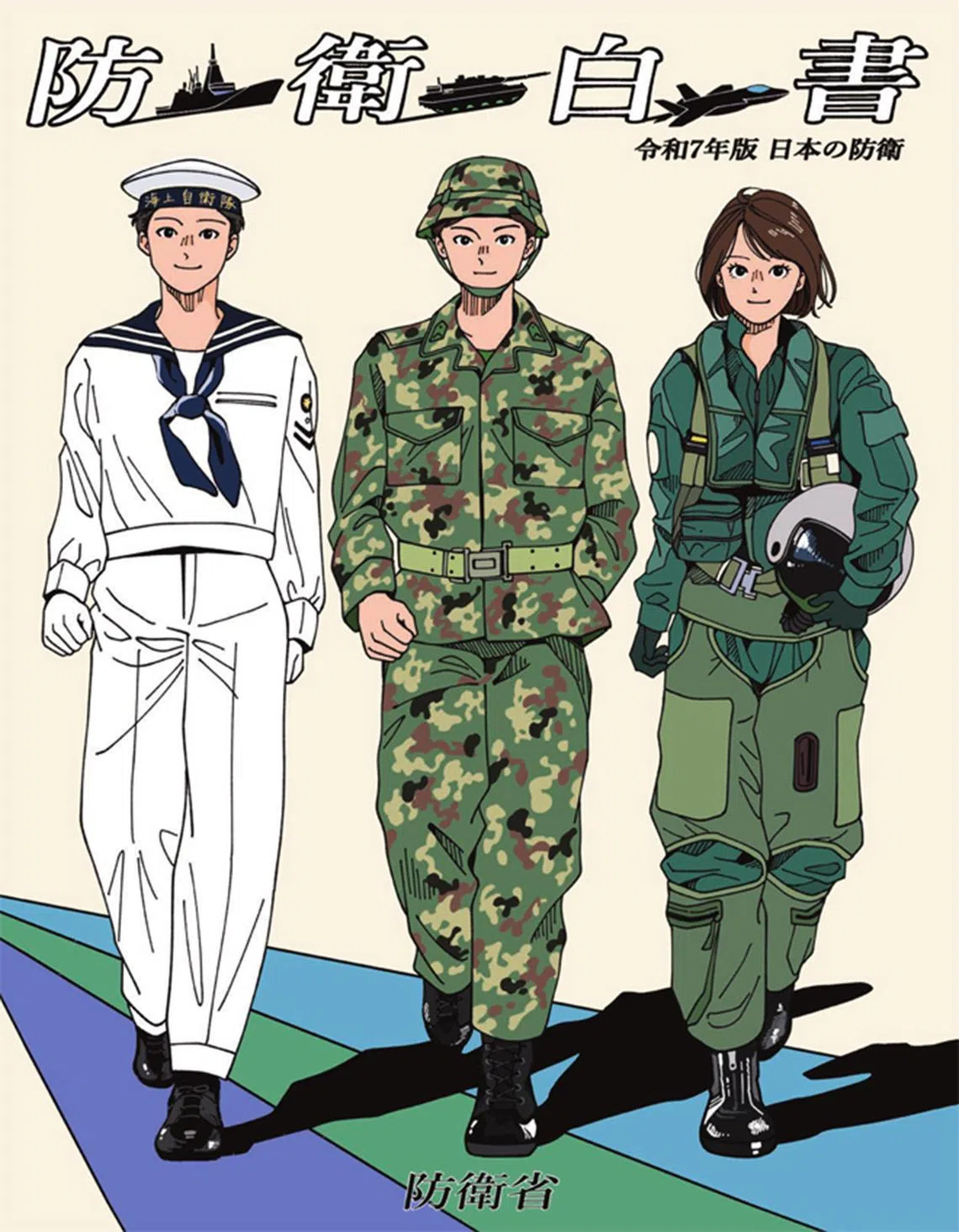‘Greatest strategic challenge’: Japan reiterates China threat in annual defence review
Sign up now: Get ST's newsletters delivered to your inbox

A Chinese JH-7 fighter-bomber flying close to a Japan Air Self-Defence Force YS-11EB intelligence-gathering aircraft over the high seas in the East China Sea on July 9.
PHOTO: AFP
Follow topic:
- China poses the "greatest strategic challenge" to Japan, prompting increased defence spending and focus on "comprehensive national power" detailed in Japan's Defence Ministry white paper.
- The Japan Self-Defence Forces (SDF) faces a recruitment crisis due to a shrinking workforce and competition from the private sector, despite outreach efforts and improved benefits.
- Japan aims to offset personnel shortages by investing in AI, drones, and unmanned technology, while improving SDF's image amid regional security tensions and negative perceptions.
AI generated
TOKYO – China’s repeated intrusions into Japanese territorial airspace and waters, coupled with a series of dangerous manoeuvres, mark a relentless campaign to change the status quo by force, Tokyo asserted in its annual defence review released on July 15.
Such actions mean China poses “an unprecedented and the greatest strategic challenge” to Japan’s security – a descriptor that was first adopted in 2022
The release of the 538-page document comes days after cannon-equipped Chinese Coast Guard ships again entered Japanese waters near the disputed Senkaku/Diaoyu islets on July 9.
That same day, a Chinese JH-7 fighter-bomber flew within 30m – roughly the length of a basketball court – of a YS-11 Japanese intelligence-gathering aircraft over the East China Sea. The following day, a JH-7 again came close to a YS-11 plane, this time within 60m.
Japan’s Defence Ministry released photographs that show that the JH-7 might have been equipped with air-to-air missiles, and stressed that such “abnormal” encounters carry a significant risk of accidental aerial collisions.
Beijing retorted that its actions were legitimate and, instead, criticised Japan for entering China’s air defence identification zone (ADIZ). China in 2013 unilaterally declared an ADIZ
These incidents come just a month after China’s unprecedented simultaneous deployment “unusually close” encounters
On July 15, Chinese Foreign Ministry spokesman Lin Jian said during a regular media briefing in Beijing that China has expressed “strong dissatisfaction and firm opposition” and lodged “a serious protest” over the White Paper, claiming that it reflects the “wrong perception” and interferes in its internal affairs.
While Japan’s Self-Defence Forces (SDF) are called upon as first responders to external threats, the extent of their capabilities is constrained by demographic pressures. The trend of declining births
“Each and every SDF personnel constitutes the greatest pillar of our defence capability,” Japanese Defence Minister Gen Nakatani wrote in the White Paper’s foreword. “Stably securing personnel is an utmost priority, and it is essential to establish arrangements so that they can dedicate themselves with pride, honour and a strong sense of mission to national defence, a duty critically important to the nation.”
Yet recruitment has consistently fallen short of targets in a nation that, unlike regional territories like Singapore, South Korea and Taiwan, does not have mandatory conscription.
This means there is no large reserve force to tap, while any attempt to mandate conscription – like in Cambodia, which said on July 14 it would do so from 2026
This is despite recent measures
The shortfall between the targeted strength and actual headcount is only widening, exacerbated by a cut-throat battle for manpower with the private sector that promises far better wages.
It is not for the lack of trying. The Defence Ministry has an ongoing recruitment blitz with direct outreach to universities and, controversially, targeted advertising at poor families. It has put up recruitment banners outside train stations and city halls, and produced snazzy advertisements on social media.
“In order to fundamentally strengthen defence capabilities in response to the most severe security environment since World War II, it is urgent and essential to secure the necessary personnel, lest the situation worsens,” the White Paper said.
A senior Defence Ministry official told The Straits Times on condition of anonymity that the recruitment challenge is typically “impacted by a better economy”. This is not unique to the SDF and is also felt in “other uniformed public sectors such as the police and fire departments”.
Tokyo has historically struggled to raise public service wages, even as it has exhorted the private sector
For the first time, the SDF is targeting millennials and Gen Z. The manga-style cover art of the defence White Paper was done by 29-year-old digital illustrator Honoka Yoshifuku, featuring three SDF personnel from the three branches of Air, Ground and Maritime, including a female pilot.
This artistic choice is noteworthy, as Tokyo uses the cover design of the White Paper to reflect the mood of a particular period.

Japan’s defence White Paper 2025 features manga-style illustrations of three Self-Defence Forces personnel from the Air, Ground and Maritime branches.
PHOTO: JAPAN MINISTRY OF DEFENCE
In 2024, the cover featured a sword being forged on an anvil to mark the SDF’s 70th anniversary and to symbolise deterrence, reflecting how Japan has been “working very hard to forge its ‘sword’ to avoid having to draw it”.
Previous covers
For 2025, the Defence Ministry devoted a new section of the report to highlight better perks. Wages are being bumped up with the “unprecedented introduction and raising of more than 30 allowances”. Starting salaries for enlistees will also be raised to 198,800 yen (S$1,725) per month, from 157,000 yen (S$1,360) per month.
Living conditions are being improved with private sleeping quarters, “stylish” furniture in shared spaces, better showers and toilets, and even internet connectivity on the high seas.
The document further humanises active service personnel through first-person anecdotes like that of Air Self-Defence Force Staff Sgt Tomohiro Miyazaki, who admitted to “experiencing first-hand the nerves from using real ammunition” during a joint live-fire training exercise with the United States.
Maritime Self-Defence Force Lieutenant (junior grade) Yukiko Nojima said she was able to “spend time in a well-balanced way” even when out at sea, with satellite communications allowing crew to keep in touch with their families on social media and even watch videos on YouTube.
But will all these perks be enough to reverse the yawning recruitment shortfall?
Professor Heng Yee Kuang of the University of Tokyo’s Graduate School of Public Policy told ST: “The SDF has difficult recruiting because the job is perceived as ‘three Ks’: kitsui (demanding/hard), kitanai (dirty) and kibishii (strict/harsh).”
Despite attempts to rehabilitate the SDF’s image, perceptions of a volatile security environment amid wars in Ukraine and the Middle East and potential conflict over Taiwan “may unfortunately entrench negative perceptions that life in the SDF only means the ‘three Ks’”, he said.
“The operational military environment is becoming harsher with ever more risky intercepts of Japanese surveillance aircraft by Chinese warplanes and more frequent, lengthier intrusions by Chinese vessels into Japanese waters,” Prof Heng added.
The silver lining, defence officials said, is that technological innovation is one way the SDF can compensate for the widening manpower shortfall.
“One way is to use unmanned technology as far as possible,” the Defence Ministry official told ST, when asked if the chronic shortage of personnel would hurt Japan’s ability to defend itself in case of an imminent war.
“We must urgently promote research and development of artificial intelligence, drones and other technologies such that we can continue our activities even if there is a lack of personnel.”


